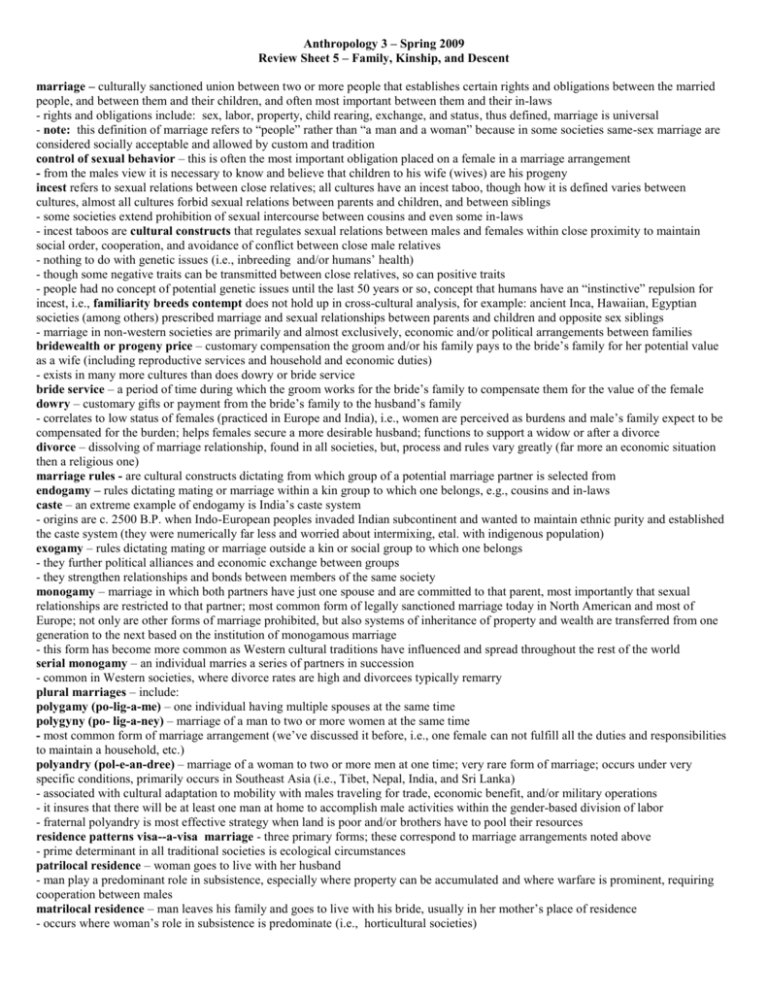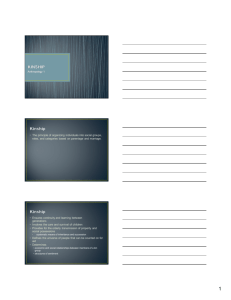Review Sheet #6 Family and Kinship
advertisement

Anthropology 3 – Spring 2009 Review Sheet 5 – Family, Kinship, and Descent marriage – culturally sanctioned union between two or more people that establishes certain rights and obligations between the married people, and between them and their children, and often most important between them and their in-laws - rights and obligations include: sex, labor, property, child rearing, exchange, and status, thus defined, marriage is universal - note: this definition of marriage refers to “people” rather than “a man and a woman” because in some societies same-sex marriage are considered socially acceptable and allowed by custom and tradition control of sexual behavior – this is often the most important obligation placed on a female in a marriage arrangement - from the males view it is necessary to know and believe that children to his wife (wives) are his progeny incest refers to sexual relations between close relatives; all cultures have an incest taboo, though how it is defined varies between cultures, almost all cultures forbid sexual relations between parents and children, and between siblings - some societies extend prohibition of sexual intercourse between cousins and even some in-laws - incest taboos are cultural constructs that regulates sexual relations between males and females within close proximity to maintain social order, cooperation, and avoidance of conflict between close male relatives - nothing to do with genetic issues (i.e., inbreeding and/or humans’ health) - though some negative traits can be transmitted between close relatives, so can positive traits - people had no concept of potential genetic issues until the last 50 years or so, concept that humans have an “instinctive” repulsion for incest, i.e., familiarity breeds contempt does not hold up in cross-cultural analysis, for example: ancient Inca, Hawaiian, Egyptian societies (among others) prescribed marriage and sexual relationships between parents and children and opposite sex siblings - marriage in non-western societies are primarily and almost exclusively, economic and/or political arrangements between families bridewealth or progeny price – customary compensation the groom and/or his family pays to the bride’s family for her potential value as a wife (including reproductive services and household and economic duties) - exists in many more cultures than does dowry or bride service bride service – a period of time during which the groom works for the bride’s family to compensate them for the value of the female dowry – customary gifts or payment from the bride’s family to the husband’s family - correlates to low status of females (practiced in Europe and India), i.e., women are perceived as burdens and male’s family expect to be compensated for the burden; helps females secure a more desirable husband; functions to support a widow or after a divorce divorce – dissolving of marriage relationship, found in all societies, but, process and rules vary greatly (far more an economic situation then a religious one) marriage rules - are cultural constructs dictating from which group of a potential marriage partner is selected from endogamy – rules dictating mating or marriage within a kin group to which one belongs, e.g., cousins and in-laws caste – an extreme example of endogamy is India’s caste system - origins are c. 2500 B.P. when Indo-European peoples invaded Indian subcontinent and wanted to maintain ethnic purity and established the caste system (they were numerically far less and worried about intermixing, etal. with indigenous population) exogamy – rules dictating mating or marriage outside a kin or social group to which one belongs - they further political alliances and economic exchange between groups - they strengthen relationships and bonds between members of the same society monogamy – marriage in which both partners have just one spouse and are committed to that parent, most importantly that sexual relationships are restricted to that partner; most common form of legally sanctioned marriage today in North American and most of Europe; not only are other forms of marriage prohibited, but also systems of inheritance of property and wealth are transferred from one generation to the next based on the institution of monogamous marriage - this form has become more common as Western cultural traditions have influenced and spread throughout the rest of the world serial monogamy – an individual marries a series of partners in succession - common in Western societies, where divorce rates are high and divorcees typically remarry plural marriages – include: polygamy (po-lig-a-me) – one individual having multiple spouses at the same time polygyny (po- lig-a-ney) – marriage of a man to two or more women at the same time - most common form of marriage arrangement (we’ve discussed it before, i.e., one female can not fulfill all the duties and responsibilities to maintain a household, etc.) polyandry (pol-e-an-dree) – marriage of a woman to two or more men at one time; very rare form of marriage; occurs under very specific conditions, primarily occurs in Southeast Asia (i.e., Tibet, Nepal, India, and Sri Lanka) - associated with cultural adaptation to mobility with males traveling for trade, economic benefit, and/or military operations - it insures that there will be at least one man at home to accomplish male activities within the gender-based division of labor - fraternal polyandry is most effective strategy when land is poor and/or brothers have to pool their resources residence patterns visa--a-visa marriage - three primary forms; these correspond to marriage arrangements noted above - prime determinant in all traditional societies is ecological circumstances patrilocal residence – woman goes to live with her husband - man play a predominant role in subsistence, especially where property can be accumulated and where warfare is prominent, requiring cooperation between males matrilocal residence – man leaves his family and goes to live with his bride, usually in her mother’s place of residence - occurs where woman’s role in subsistence is predominate (i.e., horticultural societies) neolocal residence – a married couple forms a household in a location of either father or mother resident pattern - most economic activity - indicative of industrial societies same-sex marriage - again note that anthropological definition of marriage is a union between “people” rather than “a man and a woman” because in some societies same sex marriages are socially acceptable and legally sanctioned note: distinction between biological homosexuality and social homosexuality - biological homosexuality is believed to be innate and/or genetic determined, which social homosexuality is believed to reflect a conscious choice) nuclear family consisting of one or more parents and dependent offspring; it is ego-centered and impermanent, while descent groups are permanent (lasting beyond the life spans of individual constituents) and reckoned according to a single ancestor extended family – several closely related nuclear families clustered together into a large domestic group - in many societies, descent groups and extended families are the primary units of social organization, i.e., nuclear families are traditionally embedded within larger extended families that are headed by a male(s) and sometimes his wife who runs the domesticate aspects of the extended family; usually headed by a patriarch or group of elder males; resources and wealth produced by all family members are controlled by patriarchy; females have little status and/or influence in society function and characteristics of family – family is the unit of production (i.e., works cooperatively to produce all necessitates of life - centered of social organization, including subsistence social structure, political activities, and to varying degrees religious activities kinship – is defined as a network of relatives where individuals possess certain mutual rights and obligations - other forms than in Western cultures, this form of social organization is still the primary system that people follow and have loyalty to - one of the main reasons many non-Western nations are weak and the cause of internal strife and conflicts lineage is a descent group whose members can demonstrate their common descent from an apical, known ancestor or founder - ancestor commonly lived about five generations ago - relationships between each member can be exactly stated in genealogical terms clan is a descent group whose members claim common descent from an apical ancestor (known as stipulated descent) but cannot demonstrate it descent group is a permanent social unit whose members claim common ancestry - any kinship group with a membership lineally descending from a real (historical) or fictional common ancestor unilineal descent in which individuals only recognize one line of descent, either male or female line - membership is ascribed based on birth matrilineal descent, individuals automatically join the mother’s descent group when they are born - the married couple lives with the wife's family patrilineal descent, individuals automatically join the father’s descent group when they are born - the married couple lives with the husband's family - is far more common than matrilocality Industrialism and Family Organization - the family changed drastically, that is, no longer the unit of production; wage labor became the norm - males began to move away from home to follow where jobs were - females began to move out of their paternal households - after World War II and the growth of suburbs, the extended family broke down and was replaced by neolocal residence - most prevalent residence pattern in the United States is neolocal residence by families of procreation (i.e., establishing a new residence with neither father’s or mother’s kin) - in the U.S., as in other large, industrialized societies, patterns of residence and family types may change from class to class serial monogamy – that is, individuals have more than one spouse, but never at the same time (i.e., they divorce a spouse and subsequently marry another, and so on) changes in North American kinship - in 2000, 24 percent of American households were inhabited by nuclear families - increasing representation of women in the cash work force is associated with a rise in marriage age - number of divorced Americans jumped by factor of 4.4 between 1970 - 2000, from 4.3 million in 1970 to more than 19 million in 2002 - divorce rate – today c. 50% of first marriages end in divorce, twice the national average in 1960, but slightly less than in 1980 - both males and females are marrying less and at a much older age than in the past; this is a reflection of the economic independence of women and the acceptance of alternate forms of cohabitation blended families – kin units formed when parents remarry and bring their children into new household, has risen dramatically increased other forms of social relationships - because ties of kinship and household are not always sufficient to handle all the challenges of human survival, people also form groups based on gender, age, common interest, and social rank gender groups – formed in order to share labor tasks that would be too difficult for any one individual to complete by themselves - for females this may include child rearing, for example nursing and infant care - common biological strategy is for females living closely together to “cycle menstruation” – i.e., have periods at the same time, then often become pregnant at the same time, allowing for sharing of nursing their infants - for males this includes sharing of hunting cooperation, cooperation in war, and religious obligations age groups – along with gender distinctions, are the most important factors that determine a person’s positions in society - three primary categories: immature, mature, and old people degrees of an individual’s value and wisdom, and thus importance to society are reflected in these groups







